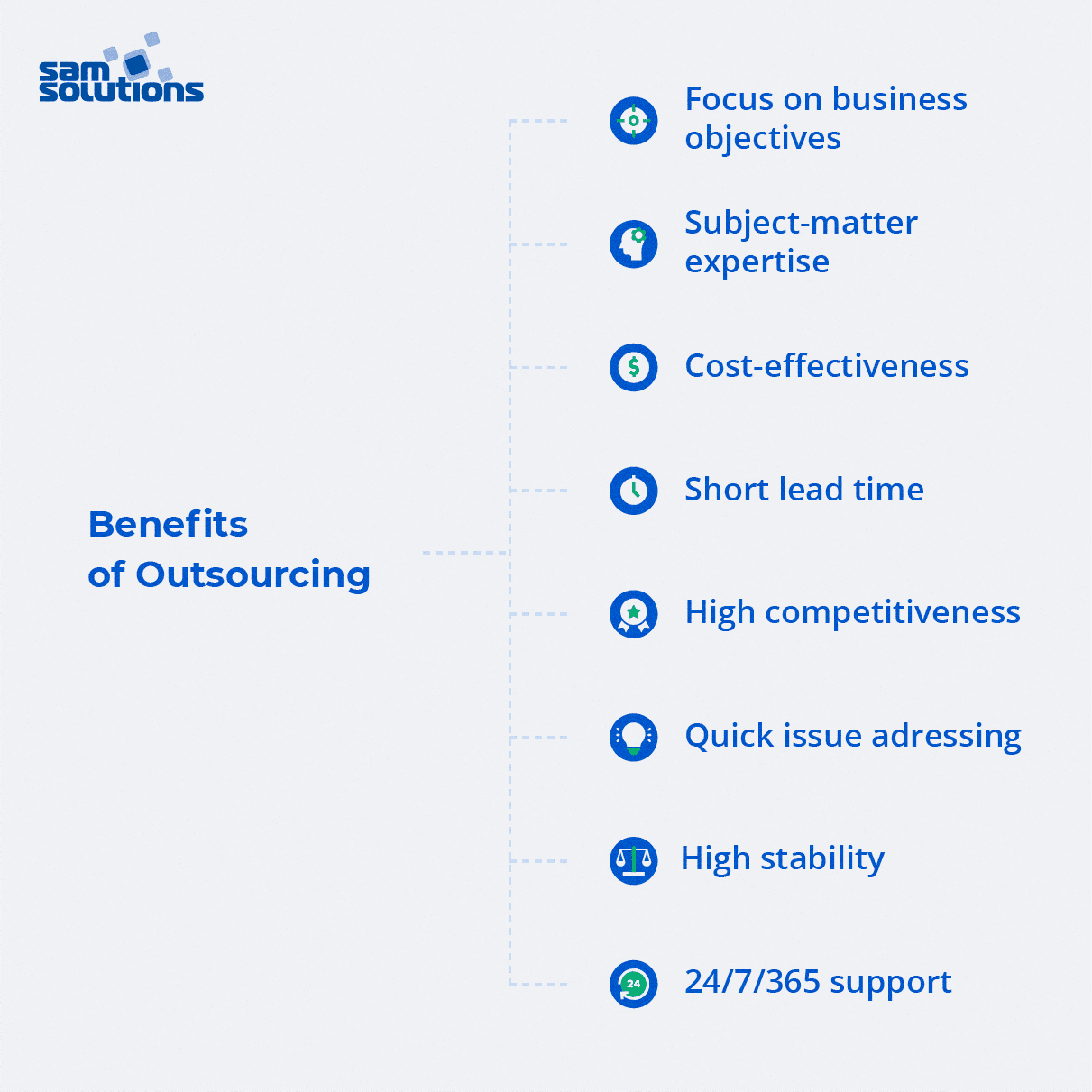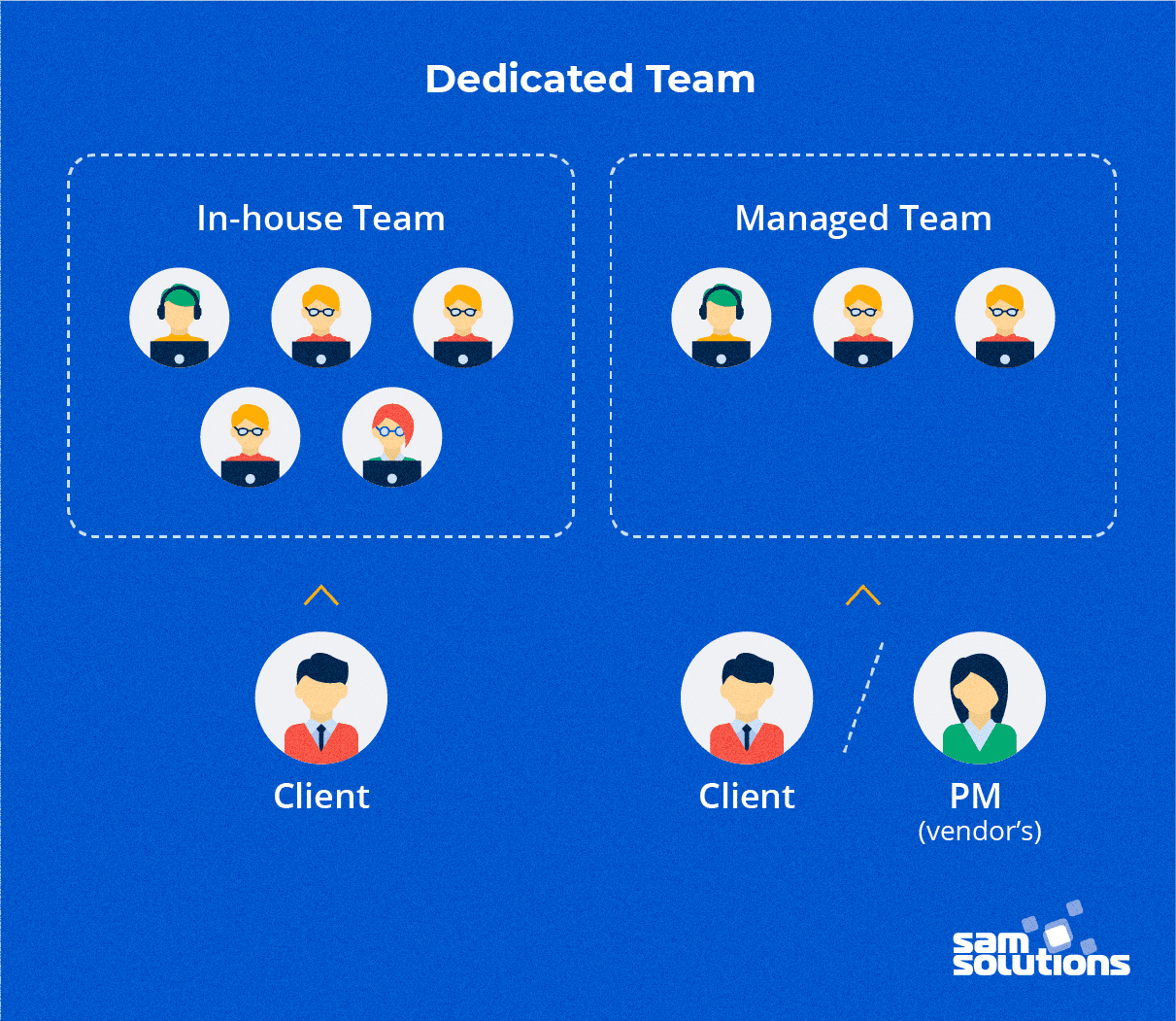The size of the global IT outsourcing market reached almost $100 billion in 2020, according to Statista, proving just how immense the IT outsourcing industry has become. What is IT outsourcing, what are its main types, and why should companies adopt it? With 30+ years of experience in IT outsourcing, we’re well placed to answer these questions.
Achieve cost-effective results and leverage top technical talent on-demand with our software outsourcing services
What Is IT Outsourcing?
IT outsourcing is the delegation of the responsibility for processes related to IT to a third party, which allows companies to redress their lack of expertise and internal resources and enables business growth and digital transformation.
IT outsourcing is a general term that describes processes ranging from the development of a specific solution to the execution of separate IT functions. Most frequently, companies rely on third-party providers to perform the following operations and business processes:
- Project implementation
- Maintenance and support
- Migrations and upgrading
- Quality assurance and audit
- IT infrastructure enablement
Benefits
Entrusting IT operations to external vendors allows companies to gain immense benefits. These are:
- Focus on core business objectives. Companies can focus on first-priority business objectives while IT becomes the vendor’s responsibility.
- Deep subject-matter expertise. Developing the required skills may take months and years, while an outsourced team provides them in no time.
- Cost-effectiveness. Building, training and support of in-house staff as well as addressing related difficulties outstrip the cost, especially if a company needs a one-off project.
- Short lead time. Businesses can kick off projects immediately and quickly adjust to changing requirements, without having to build and train an internal IT team.
- High competitiveness. Companies can implement advanced technologies in their business operations, which results in highly competitive services and products.
- Quick management of issues and minimal downtime. A professional team can fix problems more quickly and more reliably than an individual in-house support engineer.
- High software stability and reliability. The rich experience of outsourced specialists allows them to anticipate and proactively fix problems.
- 24/7/365 monitoring and support. With external IT experts, a company can keep an eye on its workload non-stop.

Limitations
These services may also be limited in some ways. These are:
- Communication issues. The remoteness of the client from the outsourced team and the time difference hinder communications.
- Cultural differences and language barriers. Cultural and language barriers may significantly complicate cooperation between the client’s and service provider’s teams.
- Compromised security. Third-party access to assets and sensitive data may threaten security.
- Lack of control. The remoteness of IT experts complicates monitoring and control.
- Time lost adjusting to the client’s specifics. Even service providers that focus on a certain industry or business domain have to adapt their operations to a client’s specifics.
- Hidden costs. Benchmarking and analysis, selecting a business partner, transfer of business processes and knowledge to an external provider, and staffing support may result in unexpected costs.
IT Outsourcing Models
With a project in mind, a CTO maps it out and works out whether the in-house IT resources can handle the required scope of work or not. Depending on the situation, one of three outsourcing service models can be chosen.
Project-Based
Also known as full-process outsourcing, this model is the most popular in IT outsourcing. The IT vendor is granted complete control and responsibility for the project, including all process stages, team management, results, deliverables and risks.
The client forms a development unit comprising the vendor’s experts. Full-process outsourcing helps companies build long-lasting relationships with their partners.

The benefits:
- Minimum involvement from the client, which allows the client to focus on first-priority tasks and processes
- Solid results and clear, predictable outcomes, provided by the Service Level Agreement
- Access to expertise and knowledge that the IT vendor possesses, which makes it possible to realize ideas of any complexity
- Vendor responsible for any risks and difficulties
The limitations:
- The client has little control of the development process.
- Project kickoff takes more time, compared to other models.
We recommend this option if you don’t have sufficient IT expertise or if your IT resources are taken up by other software projects. This mode of cooperation ensures continuity and suits those companies that require long-term services.
To build transparent and easy cooperation under this model, the client appoints a project manager (PM) to communicate with the vendor’s PM and control reporting and workflow as frequently as required.
Project requirements are agreed with the client beforehand and then provided in the specification for further reference. The vendor is responsible for the whole project and its management, and in particular for the agreed deliverables and timeline.
Dedicated Team
Also known as the managed team, in this outsourcing model the vendor works with the client’s in-house IT department on a specified scope of the assigned project. The dedicated team works independently: it doesn’t get fully integrated into or work as part of the client’s staff.
The team is managed by the vendor’s PM, and the communication is done by the client’s and the vendor’s PMs. Responsibilities and risks are shared between the two parties.

The advantages of using a dedicated team are very similar to those of full-process outsourcing:
- Quick ramp-up and upscaling, as dedicated teams are usually assembled by the vendor beforehand, and their structure is well thought out but easily adjusted to project requirements
- Little effort and time is invested in project management, as this is the vendor’s responsibility
- Better control of processes and deliverables, as in-house specialists are also involved
- Access to the vendor’s best practices and expertise
The disadvantages:
- Kick-off may take some time, as processes and workflows are being set up
- Communication and collaboration issues may arise
- Not suitable for short-term cooperation
We recommend using a dedicated team if you already have an in-house IT department and tried-and-true procedures, but:
- they are insufficient for the specific project
- your project requires certain expertise that your staff lacks
- you don’t want to hire new staff
- you would like to be involved in the decision-making.
This model suits perfectly when in-house developers are engaged with the core product and there is a side project to work on. It’s a good option when you need software maintenance and support, for example.
When working with a managed team, the client prepares project requirements beforehand, so that the vendor can assemble the team accordingly.
Staff Augmentation
This model is also known as the extended workbench, outstaffing and team extension, and the name is very descriptive: the client incorporates the vendor’s specialists into its IT team and manages them. Usually, this cooperation is temporary. External specialists work side by side with the client’s experts, to fill in certain positions, and the client is fully responsible for the project.

The pros:
- Flexibility and cost-efficiency, as the client can ramp up resources without the need to hire full-time specialists
- Quick and easy team upscaling according to client requirements
- Access to skills lacked by in-house specialists
- Complete control over the project, with the client in charge and third-party experts working as staff members
The cons:
- The client takes on full responsibility for all processes and deliverables
- Possible cooperation and communication problems
- High risk of turnover of the extended staff
We recommend staff augmentation if you have:
- established and clear-cut development processes
- an in-house IT department and tech lead
- resource or skill shortages that third-party specialists can supply.
Staff augmentation works equally well for short- and long-term projects.
Each of these three outsourcing models can be applied regardless of whether the client prefers an onshore, nearshore, or offshore service delivery model. Let’s have a quick look at each of them.

Onshoring
The onshore or local delivery model is based on engaging the local talent pool. There’s no doubt that geographic proximity encourages smooth communication; at the same time, onshoring is associated with higher labor costs and a limited pool of experts.
Offshoring
When using an offshore vendor, companies can take advantage of the vendor’s expertise and experience, while ignoring its location. Offshoring allows companies to choose from the global talent pool and have access to the best experts at a reasonable price. Most offshore companies provide English-speaking experts, adjust their working hours to those of their clients, or open offices in different time zones to enable 24/7 communication.
Nearshoring
An intermediate option, nearshore development is done by vendors who are located in neighboring or nearby countries. The advantages of nearshoring over onshoring are lower costs and a larger talent pool.
SaM Solutions is a good example of a nearshore software development partner. We provide services to companies from the DACH region (Germany, Austria and Switzerland). For this reason, we have an office in Germany to settle urgent matters and a development center in Belarus, which is only a two-hour flight away. Our development experts are fluent not only in English but also in German.
Outsourcing Pricing/Contractual Models
The choice of a pricing model is an important part of the financial effectiveness of the project. Usually, the relationship between outsourcing service providers and clients relies on one of the following pricing models.
Fixed Price
With the price determined at the start of the project and paid only when significant milestones are achieved, fixed-bid contracting places the financial risk on the vendor. The vendor must provide the required service at the promised price, regardless of the resources spent. Fixed price works well when requirements, scope and goals are clearly defined.
A clearly defined set of requirements and acceptance criteria is a prerequisite — it allows the client to properly evaluate deliverables. Estimations are based on the results of the initial analysis phase, which typically goes under a dedicated contract; any changes in the scope and deadlines must be registered in additional agreements.
Time and Materials (T&M)
The name is self-explanatory — payments are made based on the time and materials required for the project. The time and materials model is great for:
- flexible projects whose scope of work is difficult to estimate or predict and is agreed with the client before the billing period
- projects that have many unknown variables.
The client is billed based on the actual efforts required of the team members. Usually, the hourly rate for T&M is approximately 15% lower than that for the fixed price.
The Dedicated Team
In the dedicated-team (fee-per-team) model, cooperation principles are the same as those in the managed-team model. What about the pricing?
The vendor bills the client every month based on the agreed monthly rate of the team. As a rule, the hourly rate is lower than for T&M.
How to Outsource Effectively: a Piece of Firsthand Advice
Working with a reliable, experienced and proficient vendor is a must-have factor that drives success and efficiency. So, here are a few tips for finding the ideal partner.
- Look for good references. Ask your business partners, associates, or acquaintances for recommendations — the grapevine is the best way to check reliability and reputation.
- Check listings and ratings. Sites like Clutch, Goodfirms, DesignRush and similar will provide you with an idea of the company’s background, experience, expertise and client references.
- Make a benchmarking analysis. Time and money will be well spent on in-depth research: the more scrupulous you are with your research, the more likely you are to find the ideal partner.
The combination of these three methods will give you the best result — a service provider with the most relevant expertise, a positive track record and a work ethic that resonates with yours.
Once you have outlined your specific needs, communicate with each company on your list of potential partners so that you can develop a full picture of each company. This includes the following important steps:
- Reach out to learn firsthand about companies’ experience and expertise and request references to make sure your potential partner has what it takes.
- Negotiate engagement principles to decide on models that work for both of you.
- Ask for an estimate that is based on your project’s specifics.
The final step is to compare information that you have collected and choose the company that satisfies your requirements on budget, engagement models, expertise and internal culture to the greatest possible extent.
Drawing on our substantial experience, we’d like to share a few insights with those who are only starting their journey in outsourcing:
- Don’t prioritize the cost. Choosing a partner based only on the cost is risky: low cost may signal low quality. The best way to make the decision is to consider a variety of factors, as an attempt to cut costs may compromise quality and cause other issues.
- Set clear and measurable goals. You need to be clear on why you’ve decided to outsource, what your goal is, what you expect and how you can measure success. Also, you need to make sure your partner is aware of these.
- Communicate effectively. Reliable companies provide smooth communication regardless of the time zone, language and other factors, so make sure that you have complete visibility of your project and you are on the same page with your partner.
- Respect cultural specifics. Although business is business in any language, cultural characteristics must be carefully considered and anticipated — this is the key to successful cross-cultural collaboration.
From Something in Mind to Something in Kind: Meet SaM Solutions
SaM Solutions is a long-standing provider of software development services. Working for more than 30 years in outsourcing and IT, we have accumulated vast experience in a variety of technologies, IT verticals and business domains.
Over time, our company has grown into a large enterprise with offices in many European countries and the US, and comprising various subject-matter teams — those that specialize in custom software engineering, e-Commerce and CX, IoT, embedded and mobile software development, and others.
With skills and competencies to serve companies ranging from SMEs to multinational corporations, we have gained the trust of the likes of Fujitsu, Siemens, European Patent Office, the Instant Group and many others.
We build highly qualified, expert-level software engineering teams for clients around the world
SaM Solutions is a Gold Microsoft Partner, SAP Silver Partner and a trusted partner of Toradex, Coveo and FPX.
We provide first-class services to our clients in the most cost-effective way, which is why we continually invest in the development of expertise and know-how. As a result, we provide our clients with reliable, efficient and secure solutions that add value to their businesses and ensures the success of their innovations.
To learn more about IT outsourcing, get advice or get more information about SaM Solutions, contact us.



















 The Latest 15 Information Technology Trends in 2024
The Latest 15 Information Technology Trends in 2024 Top 10 Embedded Software Development Tools
Top 10 Embedded Software Development Tools IaaS vs. PaaS vs. SaaS: What’s the Difference?
IaaS vs. PaaS vs. SaaS: What’s the Difference? IoT Development: Top 15 Internet of Things Tools and Platforms in 2024
IoT Development: Top 15 Internet of Things Tools and Platforms in 2024 10 Examples of Predictive Analytics
10 Examples of Predictive Analytics












 SAP Commerce Cloud (ex.Hybris) and S/4Hana Integration
SAP Commerce Cloud (ex.Hybris) and S/4Hana Integration Java Microservices Architecture: A Comprehensive Guide
Java Microservices Architecture: A Comprehensive Guide Azure Java Development: A Comprehensive Guide
Azure Java Development: A Comprehensive Guide SAP Commerce Cloud Accelerators
SAP Commerce Cloud Accelerators Top Java Technology Trends 2024–2025
Top Java Technology Trends 2024–2025
Very easy to understand the It outsourcing models, Thank you for this article.
Outsourcing is always an important part of any company that wanted to extend company size and save cost. Thank you for sharing an amazing post with us.
IT Outsourcing is the key source to web development in recent days. IT outsourcing is booming, the reason being company opting for outsourcing don’t need to pay for high software, programs, plugins, libraries, directories, etc. These models of IT Outsourcing differs in aspects of workforce bifurcation, each model consists of a team where as in the Managed Team and Staff augmentation one more team adds on and here the specific tasks are allotted to the particular teams. Each Model is vital and is useful depending upon the type of website project required by the company.
Thanks for the comparison of the pricing models! Now I’d know for sure which to go after in case I finally bring myself to upscale my business.
It’s no wonder that outsourcing is so popular nowadays. You don’t need to hire staff, train it and control. Just handle a project to your partner — and go about your own business.
Outsourcing is an amazing way to enhance your own team if you need a specific skill or expertise. We usually turn to extending our team with offshore developers.
I work at a company that provides offshore software development services to US clients. In most of the deals, we use T&M and augmented team outsourcing models.
Thank you so much for this post! I’ve read so many of them, but every company makes its own classification, and I couldn’t get a handle on this matter. Now it’s crystal clear.